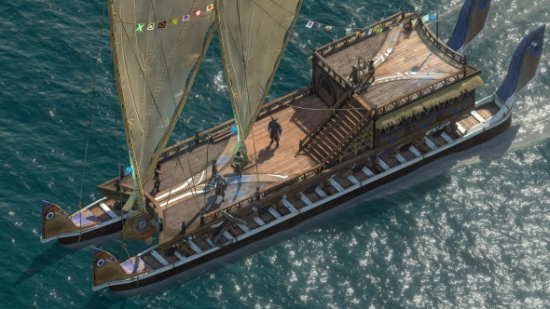This is a sponsored post courtesy of Obsidian Entertainment.
Ah! Greetings, wanderer. You look weary from your travels. Please – come in and ladle yourself a bowl of sheep’s eye soup from the pot, it’s still probably lukewarm at least. Place yourself by the hearth and warm up – we’ll throw another log on the fire. So you come seeking answers about the fabled Pillars of Eternity II: Deadfire? You’ve sought out the right stereotypical tavern owner, wanderer. Here you can learn the ways of combat, party composition, lore and more. What’s that? You also have a side quest about killing hammy article intros? What are you doing bearing your sword like that in here? Noooooooo! – *dies*.
Use the pause button
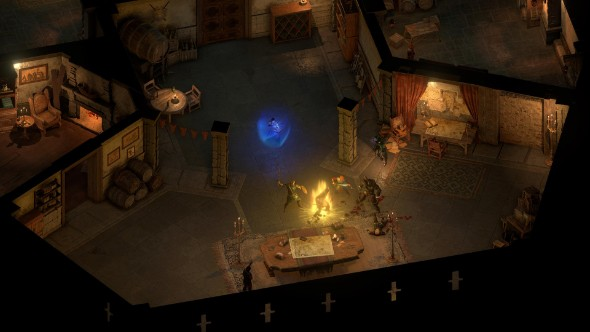
If you go into Obsidian’s old-school RPG sequel armed with only one piece of information, let it be this one: pause the game during combat. Make use of your incredible ability to stop time, tell everyone in your party what to do in an impending fight, and then resume it. If you don’t, even the simplest hostile encounter could result in the untimely slaying of your entire party and leave you rapping your fingers on the mouse mat with impotent rage.
This isn’t some huge oversight on the part of Obsidian, just so we’re clear. The Pillars series harks back to an older era in gaming, and an older design sensibility within role-playing in which you’d hit the pause key when you saw an enemy, issue orders for each party member then watch them play out until the situation evolved – whereupon you’d hit pause and do it all again.
This calculated and strategic combat style was de rigueur in the days when Pillar’s spiritual forefather Baldur’s Gate was charting. It was adapted directly from pen-and-paper rules, and D&D enthusiasts will know how irregular the flow of time can be in that setting. Over the years, stop-start combat gave way to impressively animated real-time hacking, and indeed, slashing, but a lot of the nuance and complexity was lost. Enter Pillars: an unapologetic return to the old-school ways of issuing orders, buffing party members, and even stacking their abilities, before pressing the spacebar and watching your best laid plans mess some frost spiders right up.
Build a complementary party
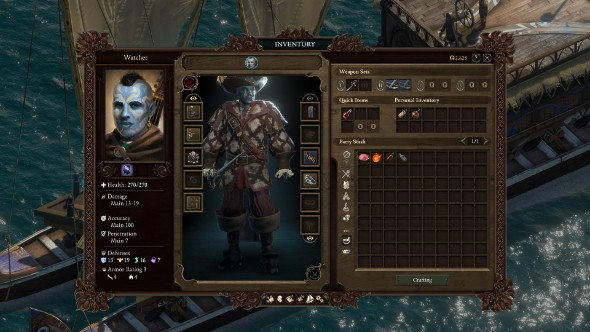
No – we don’t mean five bffs who skip around telling each other how much they love that new cuirass, or how the bastard sword they’re wiedling sets off the colour of their eyes. To survive the many challenges of Pillars of Eternity II: Deadfire, you need to compose a party of classes that complement each other’s abilities. Wandering around with a group made exclusively of willowy limbed spellcasters is asking for trouble, and the same goes for lumbering warriors who couldn’t even spell ‘magic’, let alone wield it.
Instead, it’s best to balance your classes according to their relative strengths and weaknesses. The precise balance is open to experimentation – and in fact, that’s half the fun – but if you’re coming to the Pillars, and perhaps even isometric RPGs, afresh here’s a basic template: two tanks, a DPS dealer (melee or ranged), a healer, and a utility.
Since the party size has shrunk from six to five since the first Pillars game, party composition can’t be translated exactly between the two, but the principles remain just the same. The two tanks are there to draw all the damage from whoever you’re fighting, because they’ll inevitably have more health and endurance. Fighters, Barbarians, Paladins, Monks, and even Chanters can work well in a tank partnership together, particularly if they’re given bonuses which attract enemy attention towards them and thus away from your weaker party members.
Onto the DPS dealers – the emphasis here is one dealing maximum damage per second rather than absorbing it. Barbarian, Monk, Cipher, Rogue, and Wizard are all suitable for the job, and you might even decide to sacrifice one tank for two of these – splitting them into one melee and one ranged makes it harder for enemies to position themselves properly to nullify them. Behind them is your healer – a Priest or Druid – whose primary job is buffing everyone’s health and keeping them alive. Then there’s your utility – any of the magical classes, such as Wizard, Chanter or Druid – who buffs friendlies and weakens enemies to your other party members’ attack types.
You’ll know you have alighted on a decent composition when on pausing the game you find that each party member’s default action is roughly what you would have wanted – that is, two people soaking up damage, most throwing out attacks, and one or two on buffing duty.
Understand the health system
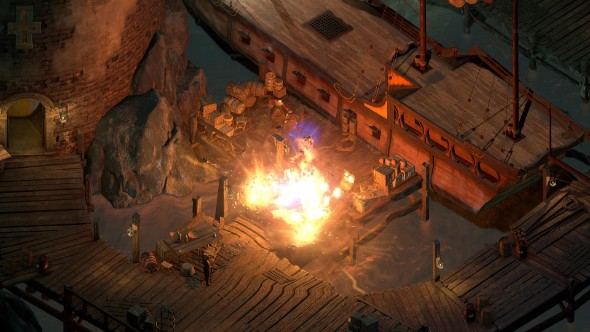
This was a confusing element in the first Pillars: health and endurance are both depleted when you take damage in combat, but their consequences and cures vary significantly. Endurance can be replenished easily using spells and items, and running out of it completely in combat will knock a character down. Health, on the other hand, can only be replenished by resting. If you lose all of a character’s health once, they’re knocked down and return on 1HP with a permanent ‘maimed’ status that means the next time they lose all their health, they’ll die. Forever. Gone. Kaput.
Given those high stakes, and the fact these two systems aren’t made terribly explicit in the original game, this proved one of the biggest stumbling blocks for beginners. Thus, it’s been revamped slightly for Pillars II. There’s just one bar dictating how, er, alive your party members are, and if it’s depleted they’ll lose 25% of their HP until they next rest. If they’re downed four times without resting, that’s them dead. So, you know, rest your injured party members.
Pay attention to positioning
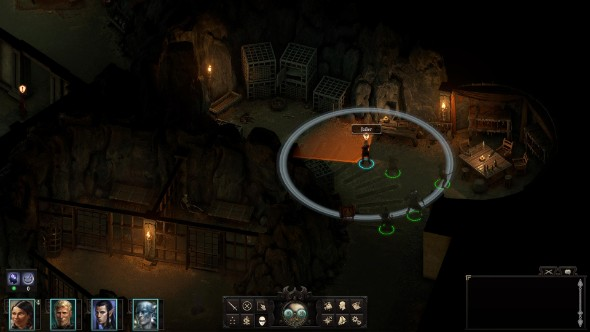
It might not seem like it at first, but where your party members are in relation to each other and their opponents has a huge bearing on the outcome of every fight.
In the simplest example possible, placing your tank in front of a doorway will plug that gap so that other opponents can’t get into the room and outflank you. Relatedly, placing your tank at the head of your group means they’re better able to perform duties like that. Don’t go in with weak spellcasters heading up your formation, like, ever.
When bonuses start being doled out for sneak and flank attacks, things get really interesting. Your spellcasters can immobilise dangerous opponents so that a Rogue might manoeuvre themselves ready to deliver the killer blow. Or your melee DPS might seize an opportunity, as your tank keeps a foe engaged at the front, to launch into a flanking attack. The pause key is very much your friend here, so use it to react to the enemy as they try to outmanoeuvre you.
Get up to speed with the story
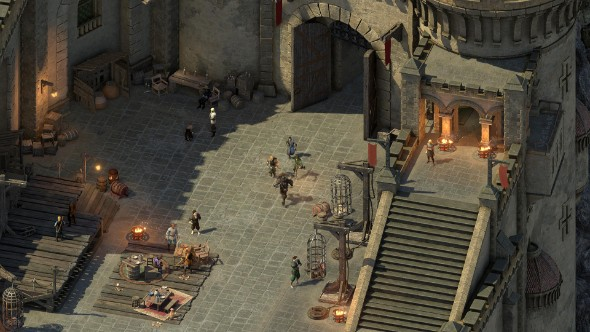
This sequel is a direct continuation of the events from the first game – you even play the same character, the Watcher. If you skipped Pillars but don’t want to feel like the conversations are going over your head, here are the cliff notes.
The Watcher journeys to Eora’s Eastern reach in search of honest adventuring work. Their humble ambitions are derailed when a storm kills their travelling party, and while seeking shelter in a nearby cave they witness a horrifying soul harvesting ritual – which, incidentally, gives The Watcher the power to read souls and relive their memories. Handy.
Keen to make sense of their disturbing visions, the Watcher meets Lord Raedric in Dyrwood who tells them about the Hollowborn plague – people born without souls, who are subsequently hung up on a tree in the middle of town. Animancers are the chief suspect but, as the Watcher learns during their investigations, the culprit is actually a chap named Thanos. He’s the one from the soul-harvesting ritual in the cave, it turns out.
Tracking down Thanos to his lair, The Watcher learns that the gods who govern their world are in fact animancers’ fabrications, put in place to keep society on a short leash. Thanos is the last of the order who created the gods, and he’s been using soul harvesting magic to stay alive and cover his tracks this whole time. The Watcher slays him, but how the rest of the story concludes depends on your earlier actions. It’s possible to carry over those consequences and characters to Pillars of Eternity II, which comes to PC on May 8th, but if you’re reading this we’re guessing that’s not going to be a factor.
